Making Yorkshire Pudding
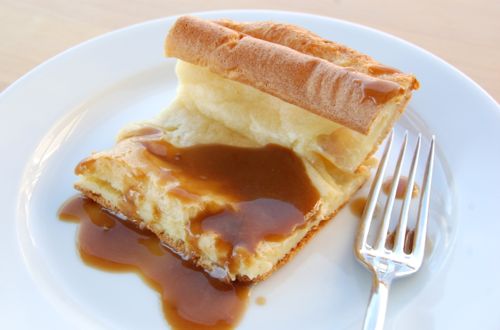
Now a true Yorkshire pudding (or so I have it on good authority) is made in one large pan, not in several small ones, and it’s served not as an accompaniment to a roast but as a first course, drizzled with gravy. Works for me. Still, once these shots were done I piled on some sliced turkey, a little cranberry and another piece o’ puddin’ and made a sandwich out of it. I can tell you that it made one heck of a Kentucky lunch! So do what you will. I know of no Yorkshireman (or woman) who’ll come ’round to check.
Begin by preheating your oven to 450 degrees Fahrenheit, selecting a baking dish or a roasting pan and gathering your ingredients. Add a couple of tablespoons of fat from your roast. Or, if you don’t have a roast use some butter, beef fat or lard as I’m doing here.

Next combine all your — room temperature — batter ingredients in a blender, food processor or stand mixer, or in a bowl if you prefer.
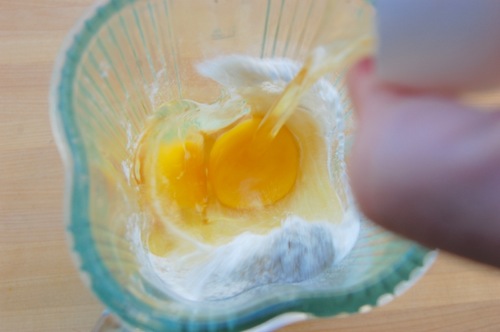
Blend, process or beat the mixture on high for 30 seconds to develop gluten, on which the success of a Yorkshire pudding depends. If you’re using a whisk, have at it for a good minute. It should look about like this:

Set the batter aside and put the pan in the oven until the fat starts to crackle and bubble, about 5 minutes, then use a pastry brush to paint it around the pan for lubrication.
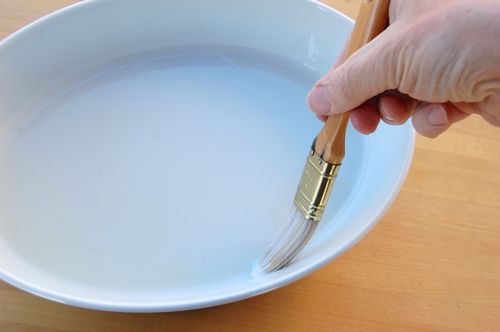
Pour in the batter.
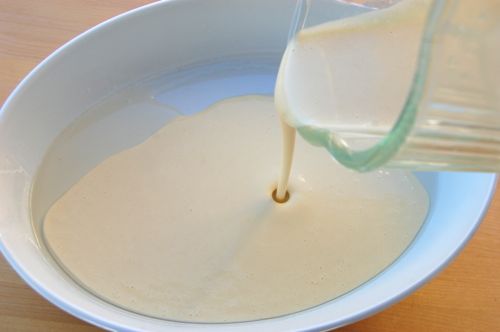
Bake for 20 minutes, then — without opening the door to check — reduce the oven to 350 and bake another ten minutes, until it puffs up dramatically and browns. There’s no set shape for Yorkshire puddings, but they often blow up into Dali-esque versions of the containers they’re in.

Cut it into squares and serve with gravy.
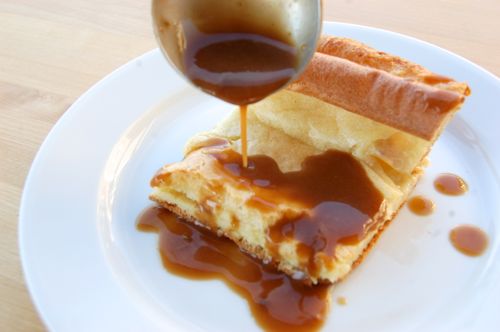
Oh yeah…keep going please. I like mine sloppy.
This looks fantastic! I am part of a group that does a themed dinner party once a month and our next theme is British food. As some of the other participants also follow the blog, I hearby call dibs.
Duly noted, Alex! You know traditional British food is a lot better than people give it credit for. Let me know what ends up on the final menu…other than meat, potato and two veg!
Thanks for the comment,
– Joe
Yorkshire pudding = popovers ?
Yorkshire pudding = BIG popover!
😉
– Joe
Any relation to Dutch babies?
Definitely!
– Joe
I’ve heard – not that I can remember where – that Yorkshire puddings were served as a first course before the meat because they’re comparatively cheap; thrifty housewives encouraged their families to fill up on them so the (far more expensive) roast would go further.
While we’re on the topic of Yorkshire pudding, I have fond childhood memories of toad-in-the-hole: make the batter as described, but scatter bite-sized bits of sausage into the dish. Let those bake for a few minutes in the oven, use the drippings to grease the dish, pour the batter over and bake as usual.
Great! Gonna try that soon, Jane. Thank you very much!
– Joe
Yum! I never make a roast with out Yorkshire pudding. It’s one of my favorite things. I invite you to link this to my recent blog hop ( it’s still open) Hugs
Thanks Katherine!
– Joe
Hey Joe,
Can I suggest another v English way to eat yorkies? With lashings of golden syrup… so good…
I believe you, Zoe! Thank you!
– Joe
I was always told that the yorkshire pudding was originally cooked under a spit-roast to catch the drippings etc. (but I’m not from Yorkshire, rather a soft Londoner). The description of Daliesque shapes is exactly right, but why did you reduce the oven temperature? I’ve never done that and thought the secret of Yorkshire puddings was a very hot oven and timing – getting them to the table immediately they came out of the oven before they collapse like a souffle.
Hi Peter!
You’re right about that. Going way back to their earliest days, Yorkshire puddings we’re made by the hearth side, and were finished under the roast. I suppose when I think of the heyday of these sorts of puddings, I think of the ones produced in modern enclosed ovens, which are puffy (versus pancake-like and swimming in drippings…which I’m sure is also delicious).
Regarding heat, I lower it so the edges don’t completely dry out. The big heat is only necessary for the first portion of the baking, to get the pudding off the ground, as it were. And while heat is necessary, the real trick to a Yorkshire pudding is thorough beating, which develops the gluten that’s necessary to trap all that elevating steam.
Thanks for the excellent comment!
– Joe
Hi,
Does anyone know about how much sugar/honey could be added to this recipe to turn it into a kind of sweet crispy cake type thing?
Thanks.
I had no idea what Yorkshire Pudding was until reading this post; I’d heard of it, but never seen it..
Turns out I make it several times a month; but for breakfast… I’ve heard them called Pop-eye Pancakes, German Pancakes, Hootenanny Pancakes.. etc.. I top mine with powdered sugar; my hubby uses applesauce and jam. 🙂
“Dutch babies” are another word for them when they’re sweet. Ty putting some apples n the bottom of the pan before you put the batter in. Terrific!
– Joe
Oh yum! Been hoping to run across this recipe for ages. Love your site and am sure I’ll be back often. Joe Pastry…perfect name! I first enjoyed Yorkshire Pudding in Aberdeen while visiting friends…she’s a great cook.
Tell me how it went, Barbara! And thanks very much!
Cheers,
– Joe